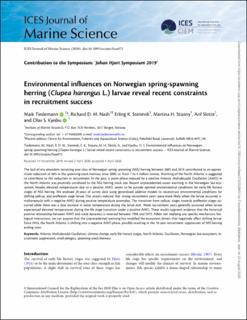| dc.contributor.author | Tiedemann, Maik | |
| dc.contributor.author | Nash, Richard David Marriott | |
| dc.contributor.author | Stenevik, Erling Kåre | |
| dc.contributor.author | Stiasny, Martina, H. | |
| dc.contributor.author | Slotte, Aril | |
| dc.contributor.author | Kjesbu, Olav Sigurd | |
| dc.date.accessioned | 2020-10-16T13:45:25Z | |
| dc.date.available | 2020-10-16T13:45:25Z | |
| dc.date.created | 2020-05-04T12:24:12Z | |
| dc.date.issued | 2020 | |
| dc.identifier.citation | ICES Journal of Marine Science. 2020, . | en_US |
| dc.identifier.issn | 1054-3139 | |
| dc.identifier.uri | https://hdl.handle.net/11250/2683418 | |
| dc.description.abstract | The lack of any abundant recruiting year class of Norwegian spring-spawning (NSS) herring between 2005 and 2015 contributed to an approximate reduction of 40% in the spawning-stock biomass since 2009, i.e. from 7 to 4 million tonnes. Warming of the North Atlantic is suggested to contribute to this reduction in recruitment. In the past, a warm phase induced by a positive Atlantic Multidecadal Oscillation (AMO) in the North Atlantic was positively correlated to the NSS herring stock size. Recent unprecedented ocean warming in the Norwegian Sea ecosystem, besides elevated temperatures due to a positive AMO, seems to be outside optimal environmental conditions for early life history stages of NSS herring. We analysed 28 years of survey data using generalized additive models to reconstruct environmental conditions for drifting yolksac and preflexion stage larvae. Our results indicate that strong recruitment years were more likely when the larvae occurred simultaneously with a negative AMO during positive temperature anomalies. The transition from yolksac stages towards preflexion stages occurred while there was a slow increase in water temperature during the larval drift. Weak recruitment years generally occurred when larvae experienced elevated temperatures during the life stage transition under a positive AMO. These results augment evidence that the historical positive relationship between AMO and stock dynamics is reversed between 1988 and 2015. Albeit not implying any specific mechanistic biological interactions, we can assume that the unprecedented warming has modified the ecosystem drivers that negatively affect drifting larvae. Since 2016, the North Atlantic is shifting into a negative AMO phase, possibly resulting in the 10-year recruitment suppression of NSS herring ending soon. | en_US |
| dc.language.iso | eng | en_US |
| dc.title | Environmental influences on Norwegian spring-spawning herring (<i>Clupea harengus</i> L.) larvae reveal recent constraints in recruitment success | en_US |
| dc.type | Peer reviewed | en_US |
| dc.type | Journal article | en_US |
| dc.description.version | publishedVersion | en_US |
| dc.source.pagenumber | 13 | en_US |
| dc.source.journal | ICES Journal of Marine Science | en_US |
| dc.identifier.doi | 10.1093/icesjms/fsaa072 | |
| dc.identifier.cristin | 1809215 | |
| dc.relation.project | Havforskningsinstituttet: 14861 | en_US |
| cristin.ispublished | true | |
| cristin.fulltext | original | |
| cristin.qualitycode | 1 | |
